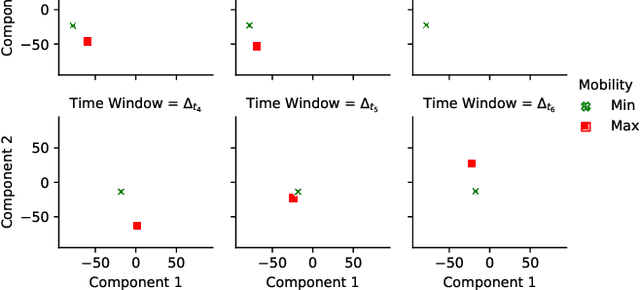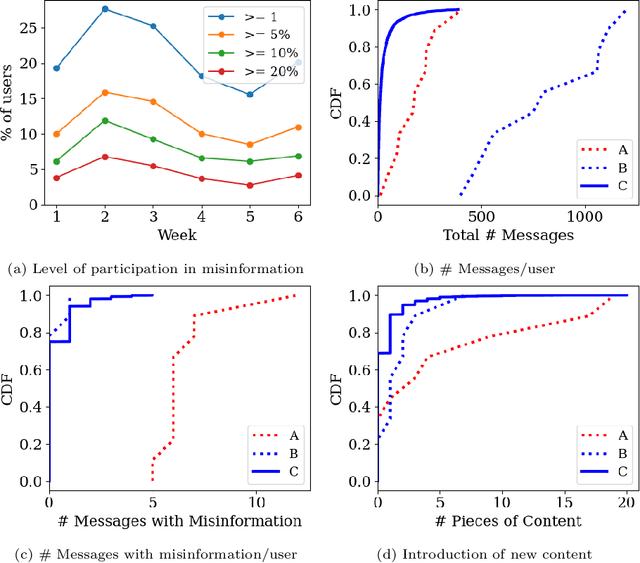Jussara M. Almeida
Benchmarking Evolutionary Community Detection Algorithms in Dynamic Networks
Jan 11, 2024Abstract:In dynamic complex networks, entities interact and form network communities that evolve over time. Among the many static Community Detection (CD) solutions, the modularity-based Louvain, or Greedy Modularity Algorithm (GMA), is widely employed in real-world applications due to its intuitiveness and scalability. Nevertheless, addressing CD in dynamic graphs remains an open problem, since the evolution of the network connections may poison the identification of communities, which may be evolving at a slower pace. Hence, naively applying GMA to successive network snapshots may lead to temporal inconsistencies in the communities. Two evolutionary adaptations of GMA, sGMA and $\alpha$GMA, have been proposed to tackle this problem. Yet, evaluating the performance of these methods and understanding to which scenarios each one is better suited is challenging because of the lack of a comprehensive set of metrics and a consistent ground truth. To address these challenges, we propose (i) a benchmarking framework for evolutionary CD algorithms in dynamic networks and (ii) a generalised modularity-based approach (NeGMA). Our framework allows us to generate synthetic community-structured graphs and design evolving scenarios with nine basic graph transformations occurring at different rates. We evaluate performance through three metrics we define, i.e. Correctness, Delay, and Stability. Our findings reveal that $\alpha$GMA is well-suited for detecting intermittent transformations, but struggles with abrupt changes; sGMA achieves superior stability, but fails to detect emerging communities; and NeGMA appears a well-balanced solution, excelling in responsiveness and instantaneous transformations detection.
* Accepted at the 4th Workshop on Graphs and more Complex structures for Learning and Reasoning (GCLR) at AAAI 2024
Understanding mobility in networks: A node embedding approach
Nov 11, 2021



Abstract:Motivated by the growing number of mobile devices capable of connecting and exchanging messages, we propose a methodology aiming to model and analyze node mobility in networks. We note that many existing solutions in the literature rely on topological measurements calculated directly on the graph of node contacts, aiming to capture the notion of the node's importance in terms of connectivity and mobility patterns beneficial for prototyping, design, and deployment of mobile networks. However, each measure has its specificity and fails to generalize the node importance notions that ultimately change over time. Unlike previous approaches, our methodology is based on a node embedding method that models and unveils the nodes' importance in mobility and connectivity patterns while preserving their spatial and temporal characteristics. We focus on a case study based on a trace of group meetings. The results show that our methodology provides a rich representation for extracting different mobility and connectivity patterns, which can be helpful for various applications and services in mobile networks.
A Hierarchical Network-Oriented Analysis of User Participation in Misinformation Spread on WhatsApp
Sep 22, 2021



Abstract:WhatsApp emerged as a major communication platform in many countries in the recent years. Despite offering only one-to-one and small group conversations, WhatsApp has been shown to enable the formation of a rich underlying network, crossing the boundaries of existing groups, and with structural properties that favor information dissemination at large. Indeed, WhatsApp has reportedly been used as a forum of misinformation campaigns with significant social, political and economic consequences in several countries. In this article, we aim at complementing recent studies on misinformation spread on WhatsApp, mostly focused on content properties and propagation dynamics, by looking into the network that connects users sharing the same piece of content. Specifically, we present a hierarchical network-oriented characterization of the users engaged in misinformation spread by focusing on three perspectives: individuals, WhatsApp groups and user communities, i.e., groupings of users who, intentionally or not, share the same content disproportionately often. By analyzing sharing and network topological properties, our study offers valuable insights into how WhatsApp users leverage the underlying network connecting different groups to gain large reach in the spread of misinformation on the platform.
 Add to Chrome
Add to Chrome Add to Firefox
Add to Firefox Add to Edge
Add to Edge